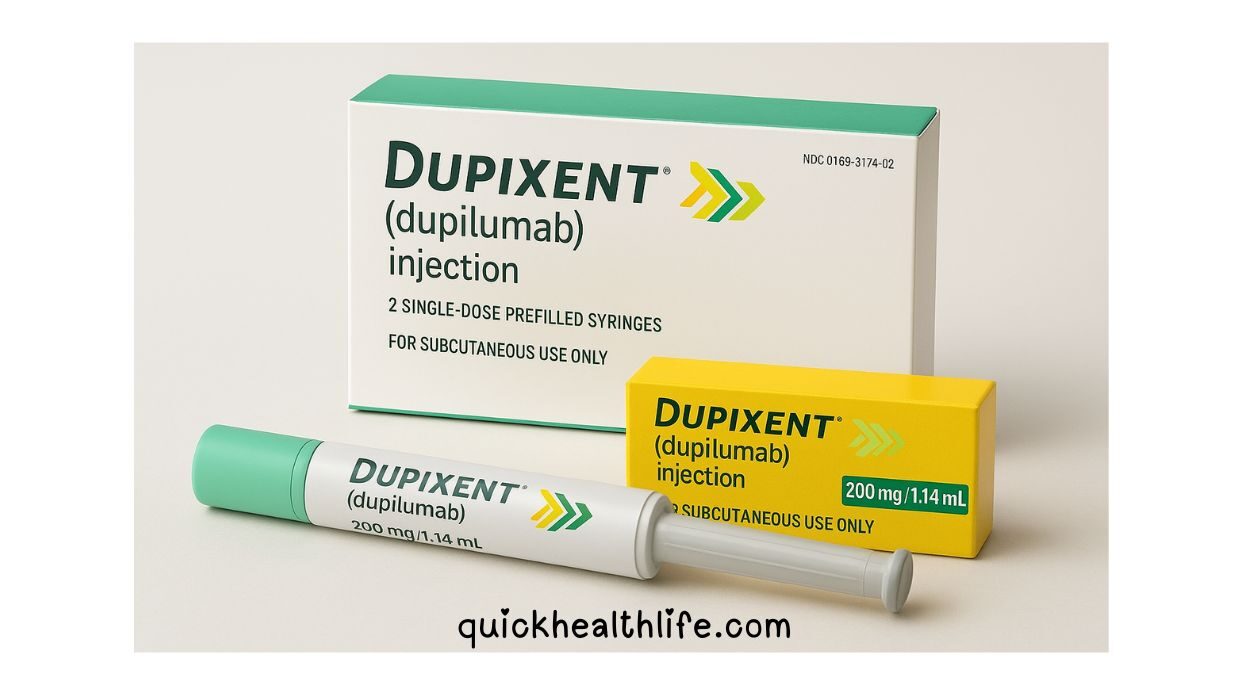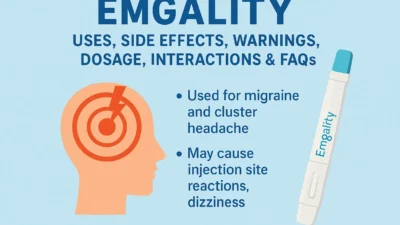Dupixent (generic name: dupilumab) is a prescription medication used to manage several chronic inflammatory conditions. It is an injectable biologic therapy that has transformed treatment for patients with moderate-to-severe eczema, asthma, and other related disorders. With its targeted approach, Dupixent works differently from traditional drugs, offering long-term symptom control and improved quality of life.
What is Dupixent Used For?
Many patients ask, what is the dupixent used for? Dupixent is primarily prescribed for:
- Atopic dermatitis (eczema): For moderate-to-severe cases unresponsive to topical treatments.
- Asthma: Specifically severe eosinophilic asthma and corticosteroid-dependent asthma.
- Chronic rhinosinusitis with nasal polyps (CRSwNP): To reduce nasal obstruction and improve breathing.
- Eosinophilic esophagitis (EoE): A rare condition causing difficulty swallowing due to esophageal inflammation.
Table of Contents
Dupixent Mechanism of Action
The dupixent mechanism of action involves blocking two inflammatory pathways: interleukin-4 (IL-4) and interleukin-13 (IL-13). These cytokines are responsible for triggering inflammatory responses in conditions such as asthma and eczema. By inhibiting them, Dupixent reduces inflammation, itching, swelling, and mucus production.
Dupixent Injection
Dupixent is available as a dupixent injection administered subcutaneously. Patients or caregivers can self-inject after proper training. The medication comes in pre-filled syringes and pens for convenience. Injections are typically given every two to four weeks, depending on the condition and prescribed dupixent dose.
Dupixent Dose
The dupixent dose varies depending on the indication:
- Atopic dermatitis (eczema): Initial dose of 600 mg (two 300 mg injections), followed by 300 mg every two weeks.
- Asthma: 400 mg or 600 mg loading dose, then 200 mg or 300 mg every two weeks.
- Chronic rhinosinusitis with nasal polyps: 300 mg every two weeks.
- Eosinophilic esophagitis: 300 mg every week.
The treating physician adjusts the regimen based on individual needs and response to therapy.
Dupixent Eczema
For patients with dupixent eczema, the medication provides relief from intense itching, redness, and skin inflammation. Clinical studies show significant improvement in skin clearance, sleep quality, and overall daily functioning. Unlike steroids, Dupixent does not cause thinning of the skin, making it a safer long-term treatment option
Dupixent Asthma
When it comes to dupixent asthma, the therapy has proven effective for patients with severe eosinophilic or corticosteroid-dependent asthma. Dupixent reduces asthma attacks, hospital visits, and reliance on oral steroids. Patients report better breathing, improved lung function, and fewer nighttime symptoms.
Dupixent Side Effects
While effective, there are potential dupixent side effects to consider. Common side effects include:
- Injection site reactions (redness, swelling, or pain).
- Conjunctivitis (eye inflammation).
- Dry eyes or eyelid swelling.
- Oral herpes infections.
- Cold sores.
Rare but serious side effects may include severe allergic reactions, eye problems, and joint pain. Patients should immediately consult their doctor if they notice vision changes, swelling, or severe rash.
What to Avoid While Using Dupixent
During treatment, certain precautions must be taken:
- Avoid live vaccines as the immune response may be compromised.
- Limit exposure to allergens or irritants that can worsen eczema or asthma.
- Refrain from discontinuing Dupixent suddenly without medical supervision.
Dupixent Interactions
Dupixent generally has fewer drug interactions compared to oral medications. However, it may interact with:
- Immunosuppressants (can alter immune response).
- Live vaccines (risk of infection).
Patients must disclose all current medications, supplements, and herbal remedies to their healthcare provider.
Dupixent Manufacturer
The dupixent manufacturer is a collaboration between Regeneron Pharmaceuticals and Sanofi. These pharmaceutical leaders developed Dupixent as the first biologic therapy targeting IL-4 and IL-13 pathways, changing treatment standards for chronic inflammatory diseases.
Dupixent Price
One major concern for patients is the dupixent price. Dupixent is considered an expensive treatment due to its biologic formulation. In the United States, the average annual cost exceeds $35,000 without insurance coverage. Financial assistance programs may reduce costs for eligible patients.
What is the Monthly Cost of Dupixent?
The question what is the monthly cost of Dupixent? depends on insurance and location. In the U.S., monthly costs can range between $3,000 to $3,500. Patients with insurance may pay significantly less, depending on their coverage and copay assistance programs.
What is the Cost of Dupixent in India?
For international patients asking, what is the cost of Dupixent in India? prices are lower compared to Western countries but still remain high. The monthly expense can range from ₹30,000 to ₹45,000, depending on the dosage and availability. Local regulations and distribution costs also affect pricing.
Dupixent in Special Populations
Children and Adolescents
Dupixent is approved for children as young as six years old with eczema and asthma. The dosage is weight-adjusted.
Pregnant or Breastfeeding Women
The safety of Dupixent in pregnancy is still under study. Physicians carefully weigh benefits against potential risks before prescribing.
Elderly Patients
Older adults may benefit from Dupixent but require close monitoring due to existing comorbidities.
FAQs About Dupixent
1. How long does Dupixent take to work?
Most patients see improvement within 2 to 4 weeks, with continued progress over several months.
2. Can Dupixent cure eczema or asthma?
Dupixent does not cure these conditions but manages symptoms effectively for long-term relief.
3. Do I need regular monitoring?
Yes, periodic medical check-ups and eye exams are recommended during therapy.
4. Can I stop Dupixent once I feel better?
No, discontinuing without medical advice can lead to relapse of symptoms.
5. Is Dupixent safe for long-term use?
Clinical studies support its safety for long-term therapy, but ongoing monitoring is essential.




[…] Read More: Dupixent: Uses, Side Effects, Dosage, Interactions, and More […]
[…] Read More: Dupixent: Uses, Side Effects, Dosage, Interactions, and More […]
[…] Read More: Dupixent: Uses, Side Effects, Dosage, Interactions, and More […]
[…] Read More: Dupixent: Uses, Side Effects, Dosage, Interactions, and More […]